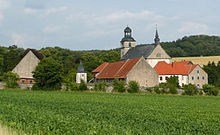Escherde Monastery
The monastery Escherde is a former Benedictine monastery in house Escherde in Hildesheim .
history
In 1203 Lippold von Escherde donated the church and four farms in Groß Escherde for the foundation of a Benedictine monastery with the confirmation of Hildesheim Bishop Hartbert . In 1236 this monastery was moved to its current location in the Hildesheim Forest, which was then called Bovingehusen . The name change to Escherte is documented in 1264 .
In 1296 the monastery was spun off from the Betheln parish association and the archdeaconate. Into Edding Hausen built Vorwerk was in 1324 dissolved. In 1441 a reform took place by Johannes Busch .
Due to the Quedlinburg Recess of 1523, the monastery fell to the Principality of Calenberg and was converted into a Protestant women's monastery. In the turmoil of the Thirty Years' War , the last canons left the monastery. In 1641 the buildings burned down.
With the restoration of the Great Hildesheim Monastery in 1643, Escherde Monastery came under prince-bishop rule again. Auxiliary Bishop Adam Adami , who administered the bishopric on behalf of Bishop Maximilian Heinrich von Bayern , worked hard to restore Escherde Monastery. It was possible to remove the accumulated debt burden. Benedictine nuns from Hamersleben formed the first new convent. Economic and convent buildings were rebuilt. In 1685 the baroque monastery church of St. Marien was completed according to plans by the Hanoverian court mason Giuseppe Crotogino . From 1709 the monastery was surrounded by a large stone wall and received a gatehouse . The church was now also the parish church for the Catholic farm workers and the few Catholics in the surrounding villages.
In the course of secularization , the Benedictine convent was dissolved in 1810 and the monastery property was sold. In 1838 the former monastery became a state domain . The village was named Haus Escherde . The Catholic parish was also abolished. The church was profaned and used as an agricultural warehouse. The inventory went to other churches. The high altar is now in the Catholic Church of St. Marien in Mehle .
The historic monastery complex with its surrounding stone wall has largely been preserved.
park
The park to the east of the old monastery was built as a French baroque garden in the early 18th century. Until the middle of the 20th century it was a popular destination for Hildesheim citizens. At that time the park was open to the public and was well maintained. It was made accessible by paths that led from the former monastery buildings through the open spaces in front of the adjoining forest park. At that time, the central axis of the former baroque garden was also recognizable. Sheep have grazed the former ground floor since the end of the 20th century . Today there is still the former baroque fountain, remains of the graft that enclosed the garden ground floor on three sides, stone baroque figures (including Apollo, Flora and Aphrodite) and the remains of a cascade and an avenue. Huge copper beeches, together with other old trees, indicate that the baroque garden, which was created around 1720, was largely converted into an English landscape park during the early 19th century under State Councilor Count Paul von Merveldt, in line with contemporary tastes .
literature
- House Escherde . In: Die Kunstdenkmale der Provinz Hannover , Vol. 26, P. 122–140 ( digitized version ).
- Ulrich Faust : Reform, Reformation and Restoration in Escherde Monastery . In: Die Diözese Hildesheim , 51st year, Hildesheim 1983, pp. 51–60.
- Ulrich Faust: Escherde . In the S. (Ed.): The women's monasteries in Lower Saxony, Schleswig-Holstein and Bremen (= Germania Benedictina , vol. 11). EOS-Verlag, St. Ottilien 1984, ISBN 3-88096-611-7 , pp. 193-216.
- Hans Goetting: The Hildesheim bishops from 815 to 1221 (1227) (= Germania Sacra , new series 20). Berlin 1984, p. 522.
- Gerhard Streich: Monasteries, monasteries and those coming in Lower Saxony before the Reformation . In: Publication of the Historical Commission for Lower Saxony and Bremen , Vol. II: Studies and Preparations for the Historical Atlas Lower Saxony , Issue 30, Hildesheim 1986, ISBN 3-7848-2005-0 , p. 60.
- Heinz-Joachim Tute: Historical gardens in the Hildesheim district . In: Yearbook of the district of Hildesheim , year 1996, pp. 145–156.
Individual evidence
- ↑ "... Bovingehusen, quod nunc Escherte dicitur, ...", H. Hoogeweg: Document book of the Hildesheim Monastery and its bishops. , P. 39, Hanover 1903.
Coordinates: 52 ° 6 ′ 57.5 ″ N , 9 ° 49 ′ 12.4 ″ E


